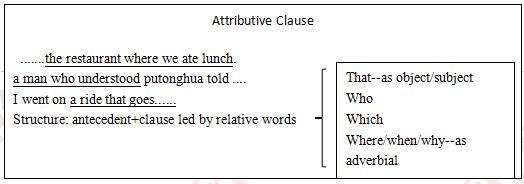网友您好, 请在下方输入框内输入要搜索的题目:
题目内容
(请给出正确答案)

二、考题解析
【教案】
Teaching Aims:
Knowledge aim: Students will master the structure of attributive Clause and understand what the relative words or antecedents are.
Ability aim: Students can use the attributive clause to describe what happened in their daily life and make up more superior sentences.
Emotional aim: Students will be inspired to study both English and putonghua very well so that they can solve problems they will meet abroad by themselves.
Teaching Key Points:
Students acquire the clause structure and know the relative words as well as antecedents.
Teaching Difficult Points:
Students can apply the structure into daily communication and get the difference between relative pronoun and adverb.
Teaching Methods:题目来源于考生回忆
Communicative teaching method, task-based teaching method, situational teaching method.
Teaching Aids:
PPT, Blackboard and so on
Teaching Procedures:
Step 1: Warming up
1.Greetings
2.Review: Show students two sentences. One is an adverbial clause of place that linked by where and the other is an attributive clause that also linked by where Where there is a will there is a way. Let them find out the differences or similarities between them and lead to what we’re going to learn today.
Step 2: Presentation
1. Read the passage briefly and and answer 3 questions. Where is the Ocean park? Who helped us? How was the ride? To lead the three underlined parts Then write down the three sentences students choose from the passage after reading.
2.Explain the common parts of these three sentences and show the structure of attributive clause.
3.Tell students that when the antecedent is a person or an object, we should choose different relative words. Also, they should understand the difference between attributive clause linked by where and the adverbial clause of place linked by where.题目来源于考生回忆
Step 3: Practice
1. Give them some sentences with blankets and let them choose the proper relative words.
2. Show them several clauses and find out which are attributive clauses.
Step 4: Production
Discussion and share: students work in pairs to describe their travel by using attributive clauses; teacher will give them 5 minutes to prepare it and 5 minutes later, invite some students to share their experiences.
Step 5: Summary & Homework
Summary : students look at the blackboard and summarize this class.
Homework:students find more rules about attributive clauses and prepare for the next class.
Blackboard design:

参考答案
参考解析
解析:暂无解析
更多 “ 二、考题解析 【教案】 Teaching Aims: Knowledge aim: Students will master the structure of attributive Clause and understand what the relative words or antecedents are. Ability aim: Students can use the attributive clause to describe what happened in their daily life and make up more superior sentences. Emotional aim: Students will be inspired to study both English and putonghua very well so that they can solve problems they will meet abroad by themselves. Teaching Key Points: Students acquire the clause structure and know the relative words as well as antecedents. Teaching Difficult Points: Students can apply the structure into daily communication and get the difference between relative pronoun and adverb. Teaching Methods:题目来源于考生回忆 Communicative teaching method, task-based teaching method, situational teaching method. Teaching Aids: PPT, Blackboard and so on Teaching Procedures: Step 1: Warming up 1.Greetings 2.Review: Show students two sentences. One is an adverbial clause of place that linked by where and the other is an attributive clause that also linked by where Where there is a will there is a way. Let them find out the differences or similarities between them and lead to what we’re going to learn today. Step 2: Presentation 1. Read the passage briefly and and answer 3 questions. Where is the Ocean park? Who helped us? How was the ride? To lead the three underlined parts Then write down the three sentences students choose from the passage after reading. 2.Explain the common parts of these three sentences and show the structure of attributive clause. 3.Tell students that when the antecedent is a person or an object, we should choose different relative words. Also, they should understand the difference between attributive clause linked by where and the adverbial clause of place linked by where.题目来源于考生回忆 Step 3: Practice 1. Give them some sentences with blankets and let them choose the proper relative words. 2. Show them several clauses and find out which are attributive clauses. Step 4: Production Discussion and share: students work in pairs to describe their travel by using attributive clauses; teacher will give them 5 minutes to prepare it and 5 minutes later, invite some students to share their experiences. Step 5: Summary & Homework Summary : students look at the blackboard and summarize this class. Homework:students find more rules about attributive clauses and prepare for the next class. Blackboard design: ” 相关考题
考题
已知某国国际收支平衡表中,经常项目差额160亿美元,资本和金融项目差额为-100亿美元,误差与遗漏为1o亿美元,则该国储备资产增减额为( )。A.70亿元
B.-70亿美元
C.+60亿美元
D.+270亿美元
热门标签
最新试卷
